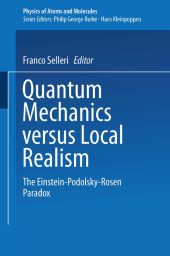 Neuerscheinungen 2012Stand: 2020-01-07 |
Schnellsuche
ISBN/Stichwort/Autor
|
Herderstraße 10
10625 Berlin
Tel.: 030 315 714 16
Fax 030 315 714 14
info@buchspektrum.de |

F. Selleri
Quantum Mechanics Versus Local Realism
The Einstein-Podolsky-Rosen Paradox
Herausgegeben von Selleri, F.
Softcover reprint of the original 1st ed. 1988. 2012. xviii, 461 S. 3 SW-Abb. 229 mm
Verlag/Jahr: SPRINGER, BERLIN 2012
ISBN: 1-468-48776-0 (1468487760)
Neue ISBN: 978-1-468-48776-3 (9781468487763)
Preis und Lieferzeit: Bitte klicken
If you have two small objects, one here on Earth and the other on the planet Pluto, what would you say of the following statement: No modification of the properties of the object on the earth can take place as a consequence of an interaction of the distant object with a third body also located on Pluto? The opinion that the previous statement is correct is very natural, but modern quantum theory implies that it must be wrong in certain cases. Consider in fact two arbitrary objects separated by such a large distance that they are unable to exert any important mutual influence. It is possible to show rigorously that a measurable physical quantity exists, with a value more than 40% different from the value theoretically predicted by quantum mechanics. Necessarily then, either space is largely an illusion of our senses and it does not exist objectively, or information can be sent from the future to the past, or ... something important has to be changed in modern physics. This is the essence of the Einstein-Podolsky-Rosen (EPR) paradox. A paradox is an argument that derives absurd conclusions by valid deduction from acceptable premises. In the case of the EPR paradox the absurd conclusion is that Bellīs observable d should have two different values d = 2.Ji and The "acceptable premises" are the following: 1. All the empirical predictions of the existing quantum theory are correct.
1 History of the Einstein-Podolsky-Rosen Paradox.- 2 Are Faster-Than-Light Influences Necessary?.- 3 All the Inequalities of Einstein Locality.- 4 Einstein-Podolsky-Rosen Experiments Using the Decays of ?c or J/? into ??? ? ?-?p?+p?.- Chapter5 Einstein-Podolsky-Rosen Paradox for the K0-K?0 and B0-B?0 Systems.- 6 Even Local Probabilities Lead to the Paradox.- 7 The Experimental Investigation of the Einstein-Podolsky-Rosen Question and Bellīs Inequality.- 8 Rapisardaīs Experiment: Testing Quantum Mechanics versus Local Hidden-Variable Theories with Dichotomic Analyzers.- 9 Nonlocality and the Einstein-Podolsky-Rosen Experiment as Understood through the Quantum-Potential Approach.- 10 Interpretation of the Einstein-Podolsky-Rosen Effect in Terms of a Generalized Causality.- 11 Quantum Action-at-a-Distance: The Mystery of Einstein-Podolsky-Rosen Correlations.- 12 Particle Trajectories and Quantum Correlations.- 13 Bellīs Inequality and the Nonergodic Interpretation of Quantum Mechanics.- 14 An Extended-Probability Response to the Einstein-Podolsky-Rosen Argument.- 15 The Search for Hidden Variables in Quantum Mechanics.- 16 Variable Detection Probability Models for Einstein-Podolsky-Rosen-Type Experiments.- 17 Stochastic Electrodynamics and the Einstein-Podolsky-Rosen Argument.- 18 Explicit Calculations with a Hidden-Variable Spin Model.- 19 Symmetric and Asymmetric Models for Atomic Cascade Experiments.


